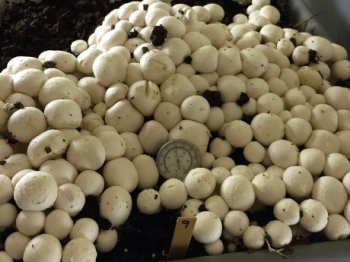
In a letter dated April 13, 2016, the US Department of Agriculture's Animal and Plant Health Inspection Service confirmed to Yinong Yang, associate professor of plant pathology, that the anti-browning mushroom he developed using a gene-editing technique known as CRISPR-Cas9 would not be subject to USDA approval. The notification apparently clears the way for the potential commercial development of the mushroom, which is the first CRISPR-Cas9 gene-edited crop deemed to require no regulatory review by USDA.
Why does this anti-browning mushroom not require USDA regulation? Because, Yang explained, unlike most GMO crops, which receive DNA from foreign organisms such as bacteria or other plant species, this mushroom is transgene-free, thanks to the CRISPR-Cas9 tool. "Our genome-edited mushroom has small deletions in a specific gene but contains no foreign DNA integration in its genome," said Yang, who is also an affiliate of Penn State's Huck Institutes of the Life Sciences. "Therefore, we believed that there was no scientifically valid basis to conclude that the CRISPR-edited mushroom is a regulated article based on the definition described in the regulations."
USDA-APHIS agreed, touching off extensive coverage – and renewed debate – in such media outlets as Nature, the Washington Post, National Public Radio and other outlets around the world.
CRISPR stands for clustered regularly interspaced short palindromic repeats. It's a relatively new and revolutionary way to modify an organism's genome by precisely delivering a DNA-cutting enzyme – Cas9 – to a targeted region of DNA. The resulting modification can delete or replace specific DNA pieces, thereby promoting or disabling certain traits.
In this case, the gene editing stops production of a specific enzyme that causes mushrooms to turn brown. The end product is a mushroom with longer shelf life that resists blemishes caused by handling or mechanical harvesting, but without DNA from a foreign organism.
"This technology holds promise for precision breeding of crops with many desirable traits, such as low levels of food allergens or toxins, disease resistance, drought tolerance, and efficient nitrogen and phosphorous utilization," Yang said. "These agronomic traits not only help reduce pesticide, fertilizer and water usage, but also improve food quality and safety."
The USDA ruling could open the door for many other GMO crops developed using CRISPR-Cas9 technology. In fact, less than a week after USDA's notification regarding Yang's anti-browning mushroom, the agency also ruled that a CRISPR-Cas9-edited corn variety developed by DuPont Pioneer also would require no USDA approval.
In the long run, Yang believes that CRISPR-Cas9 could change the public dialogue about GMOs. "There's too much divisiveness and hostility between pro- and anti-GMO camps," he said. "I hope development of the new technology will facilitate rational and productive dialogue among diverse groups of people, with a common goal to achieve food safety, food security, and agricultural and environmental sustainability."
Yang has filed a provisional patent application on his anti-browning mushroom, and he said the next step in possibly commercializing it would be submitting it for review to the Food and Drug Administration. "Anything for food or feed consumption, usually the company submits the data to FDA for approval," he told NPR.
Although legally not required, FDA approval is a prudent step to take prior to commercialization, according to Yang. "Before taking it to the market, it is essential to demonstrate scientifically that a gene-edited crop is as safe as conventional and organic crops."
Meanwhile, the federal government has begun a review of its regulatory framework governing the approval of GMOs to take into account newer technologies, such as CRISPR-Cas9. So, Yang pointed out, it's a safe bet that the public debate and dialogue won't be subsiding anytime soon.
Source: Penn State University



 Classifieds
Classifieds

